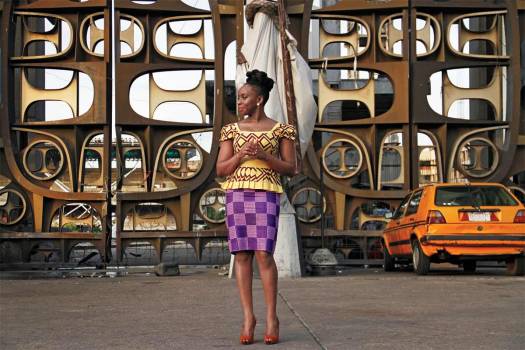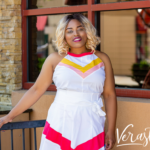There I was, reading through my Elle Magazine March 2014 issue, and there she was: Chimamanda — my favorite best friend who doesn’t know it yet. The title of the article is, “Why Can’t A Smart Woman Love Fashion?” And yes, why not? I know that people typically think of fashion magazines as picture books, but I quite enjoy reading the articles. I don’t read everything, but when I do, I enjoy it. And I especially enjoyed this one. Read it below:
_______________________________________________________________________________
As a child, I loved watching my mother get dressed for Mass. She folded and twisted and pinned her ichafu until it sat on her head like a large flower. She wrapped her george—heavy beaded cloth, alive with embroidery, always in bright shades of red or purple or pink—around her waist in two layers. The first, the longer piece, hit her ankles, and the second formed an elegant tier just below her knees. Her sequined blouse caught the light and glittered. Her shoes and handbag always matched. Her lips shone with gloss. As she moved, so did the heady scent of Dior Poison. I loved, too, the way she dressed me in pretty little-girl clothes, lace-edged socks pulled up to my calves, my hair arranged in two puffy bunny-tails. My favorite memory is of a sunny Sunday morning, standing in front of her dressing table, my mother clasping her necklace around my neck, a delicate gold wisp with a fish-shape pendant, the mouth of the fish open as though in delighted surprise.
For her work as a university administrator, my mother also wore color: skirt suits, feminine swingy dresses belted at the waist, medium-high heels. She was stylish, but she was not unusual. Other middle-class Igbo women also invested in gold jewelry, in good shoes, in appearance. They searched for the best tailors to make clothes for them and their children. If they were lucky enough to travel abroad, they shopped mostly for clothes and shoes. They spoke of grooming almost in moral terms. The rare woman who did not appear well dressed and well lotioned was frowned upon, as though her appearance were a character failing. “She doesn’t look like a person,” my mother would say.
As a teenager, I searched her trunks for crochet tops from the 1970s. I took a pair of her old jeans to a seamstress who turned them into a miniskirt. I once wore my brother’s tie, knotted like a man’s, to a party. For my 17th birthday, I designed a halter maxidress, low in the back, the collar lined with plastic pearls. My tailor, a gentle man sitting in his market stall, looked baffled while I explained it to him. My mother did not always approve of these clothing choices, but what mattered to her was that I made an effort. Ours was a relatively privileged life, but to pay attention to appearance—and to look as though one did—was a trait that cut across class in Nigeria.
When I left home to attend university in America, the insistent casualness of dress alarmed me. I was used to a casualness with care—T-shirts ironed crisp, jeans altered for the best fit—but it seemed that these students had rolled out of bed in their pajamas and come straight to class. Summer shorts were so short they seemed like underwear, and how, I wondered, could people wear rubber flip-flops to school?
Still, I realized quickly that some outfits I might have casually worn on a Nigerian university campus would simply be impossible now. I made slight amendments to accommodate my new American life. A lover of dresses and skirts, I began to wear more jeans. I walked more often in America, so I wore fewer high heels, but always made sure my flats were feminine. I refused to wear sneakers outside a gym. Once, an American friend told me, “You’re overdressed.” In my short-sleeve top, cotton trousers, and high wedge sandals, I did see her point, especially for an undergraduate class. But I was not uncomfortable. I felt like myself.
My writing life changed that. Short stories I had been working on for years were finally receiving nice, handwritten rejection notes. This was progress of sorts. Once, at a workshop, I sat with other unpublished writers, silently nursing our hopes and watching the faculty—published writers who seemed to float in their accomplishment. A fellow aspiring writer said of one faculty member, “Look at that dress and makeup! You can’t take her seriously.” I thought the woman looked attractive, and I admired the grace with which she walked in her heels. But I found myself quickly agreeing. Yes, indeed, one could not take this author of three novels seriously, because she wore a pretty dress and two shades of eye shadow.
I had learned a lesson about Western culture: Women who wanted to be taken seriously were supposed to substantiate their seriousness with a studied indifference to appearance. For serious women writers in particular, it was better not to dress well at all, and if you did, then it was best to pretend that you had not put much thought into it. If you spoke of fashion, it had to be either with apology or with the slightest of sneers. The further your choices were from the mainstream, the better. The only circumstance under which caring about clothes was acceptable was when making a statement, creating an image of some sort to be edgy, eclectic, counterculture. It could not merely be about taking pleasure in clothes.
A good publisher had bought my novel. I was 26 years old. I was eager to be taken seriously. And so began my years of pretense. I hid my high heels. I told myself that orange, flattering to my skin tone, was too loud. That my large earrings were too much. I wore clothes I would ordinarily consider uninteresting, nothing too bright or too fitted or too unusual. I made choices thinking only about this: How should a serious woman writer be? I didn’t want to look as if I tried too hard. I also wanted to look older. Young and female seemed to me a bad combination for being taken seriously.
Once, I brought a pair of high heels to a literary event but left them in my suitcase and wore flats instead. An old friend said, “Wear what you want to; it’s your work that matters.” But he was a man, and I thought that was easy for him to say. Intellectually, I agreed with him. I would have said the same thing to someone else. But it took years before I truly began to believe this.
I am now 36 years old. During my most recent book tour, I wore, for the first time, clothes that made me happy. My favorite outfit was a pair of ankara-print shorts, a damask top, and yellow high-heel shoes. Perhaps it is the confidence that comes with being older. Perhaps it is the good fortune of being published and read seriously, but I no longer pretend not to care about clothes. Because I do care. I love embroidery and texture. I love lace and full skirts and cinched waists. I love black, and I love color. I love heels, and I love flats. I love exquisite detailing. I love shorts and long maxi dresses and feminine jackets with puffy sleeves. I love colored trousers. I love shopping. I love my two wonderful tailors in Nigeria, who often give me suggestions and with whom I exchange sketches. I admire well-dressed women and often make a point to tell them so. Just because. I dress now thinking of what I like, what I think fits and flatters, what puts me in a good mood. I feel again myself—an idea that is no less true for being a bit hackneyed.
I like to think of this, a little fancifully, as going back to my roots. I grew up, after all, in a world in which a woman’s seriousness was not incompatible with an interest in appearance; if anything, an interest in appearance was expected of women who wanted to be taken seriously.
My mother made history as the first woman to be registrar of the University of Nigeria at Nsukka; her speeches at senate meetings were famous for their eloquence and brilliance. Now, at 70, she still loves clothes. Our tastes, though, are very different. She wishes I were more conventional. She would like to see me wearing jewelry that matches and long hair weaves. (In her world, better one real-gold set than 20 of what she calls “costume”; in her world, my kinky hair is “untidy.”) Still, I am my mother’s daughter, and I invest in appearance.
Written by Chimamanda Ngozi Adichie
e509a15836a8d4fabc10030c9dd77c82bd30b2dad07d8240eb
_____________________________________________________________________________
Great article, Chimamanda! Too proud of you 🙂
Read the article here on Elle.com.







